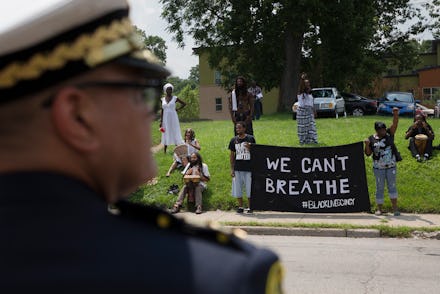Why the Killing of an Unarmed Black Man Has Cincinnati Police on Edge Right Now

Chief Jeffrey Blackwell of the Cincinnati Police Department had one major takeaway from the video that shows Samuel Dubose being killed: "The video is not good."
City Manager Harry Black had an equally dire assessment of the footage, according to WCPO: "It's not a good situation. It's a tragic situation. Someone has died that did not necessarily need to die."
The video had not been publicly released as of Wednesday morning. It was recorded on the body camera attached to University of Cincinnati police Officer Ray Tensing, who shot and killed Dubose, a 43-year-old unarmed black man, during an off-campus traffic stop July 19.
In fact, Hamilton County Prosecutor Joe Deters told reporters Wednesday that Tensing's actions were "without question a murder," and Tensing will face charges of murder as the result of grand jury deliberation, WCPO News reports. Tensing surrendered to Hamilton County on Wednesday afternoon.
Two University of Cincinnati campuses have cancelled classes in anticipation of this decision, which even Tensing's lawyer anticipated going poorly. "Given the political climate of the situation, I would not be astounded if an indictment is returned," attorney Stuart Matthews told the Cincinnati Enquirer.
But withholding the footage, which the Cincinnati Enquirer and other outlets have sued to have released, for this long is not sitting well with Dubose's family, or their lawyers. The outcome of the grand jury threatens to undermine years of widely heralded progress in the city's fraught relationship between its police and black residents.
Here's what that means:
1. Cincinnati has a history of racial tension.
In April 2001, unrest broke out in Cincinnati's Over the Rhine neighborhood when police killed an unarmed 19-year-old named Timothy Thomas in a darkened alley. The uprising lasted 72 hours and "led to hundreds of arrests and millions of dollars of property damage," according to the Marshall Project.
It was not the first time unrest had engulfed the region. In 1968, the assassination of Martin Luther King Jr. in April and the killing of a black waitress by two white men later that year both sparked further violence in Cincinnati, which was followed up by multiple reports and investigations — most notably in 1968, 1979, 1981, 1987 and 1995 — showing the scale of Cincinnati's racist policing patterns, including discriminatory hiring practices and civil rights violations against citizens.
2. But there seems to have been progress.
After the 2001 unrest, the Department of Justice stepped in and collaborated with the Cincinnati police and local community groups to create a set of reform guidelines.
The police also brought in the RAND Corporation to keep track of its progress, using data on traffic stops, interactions with black residents and surveys on community attitudes toward the police to bolster its findings.
The results, per RAND, showed what looked like overwhelming improvement. The Cincinnati Police Department has since been heralded as a national model, and an example for other harried departments to follow. From the Marshall Project:
"[The] federal judge who deemed the [New York Police Department's] stop-and-frisk tactics unconstitutional recommended that officials follow Cincinnati's example as it constructs its reform plan. Albuquerque, [New Mexico,] whose police department is under Department of Justice review because of complaints of excessive force, hired a former Cincinnati police chief for advice. And in Ferguson, [Missouri,] residents and civil rights lawyers have consulted with Cincinnati's black leadership to discuss ways to foster better police relations in the wake of the Michael Brown case."
3. There has also been criticism.
The Ohio chapter of the American Civil Liberties Union published a set of findings from a University of Cincinnati study that found the RAND Corporation's methodology was misleading in some places, often overstating the extent to which survey results actually showed as much improvement as they seemed to.
The Marshall Project, in a 2014 report, wrote that many black residents still haven't seen the fruits of this progress:
"[A] close examination of Cincinnati's experiments with new approaches to policing suggests that the marketing of its "model" may have outpaced the lasting changes. If anything, Cincinnati highlights the depth of the problems and the complex challenges of federal intervention in racially divided cities...
4. Then there's this perhaps irrelevant but still intriguing bit of data.
A PLOS ONE study from earlier this year found that Ohio and Kentucky have the highest number of Google searches for the word "nigger" in America, according to Cincinnati's WCPO.
The story of Sam Dubose has been circulating furiously on social media this week. It fits firmly into the broader pattern of anti-black police violence that's galvanized citizens and advocates nationwide over the past year. While it's key to note that this incident involved a University of Cincinnati Police Department officer, not the Cincinnati Police Department, it speaks to a history of racial tension and violence in the city that encompasses the same set of issues.
And with the grand jury announcement and possible footage release coming soon, it's important to contextualize why people are upset.
h/t Daily Kos
July 29, 1:22 p.m. EST: This story has been updated.